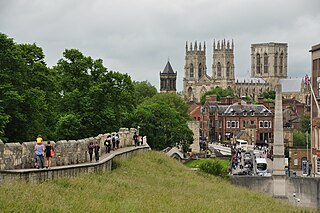
A borough is an administrative division in various English-speaking countries. In principle, the term borough designates a self-governing walled town, although in practice, official use of the term varies widely.

The counties of Ireland are historic administrative divisions of the island. They began as Norman structures, and as the powers exercised by the Cambro-Norman barons and the Old English nobility waned over time, new offices of political control came to be established at a county level. The number of counties varied depending on the time period, however thirty-two is the traditionally accepted and used number.

City status in the United Kingdom is granted by the monarch of the United Kingdom to specific centres of population, which might or might not meet the generally accepted definition of cities. As of 22 November 2022, there are 76 cities in the United Kingdom—55 in England, seven in Wales, eight in Scotland, and six in Northern Ireland. Although it carries no special rights, the status of city can be a marker of prestige and confer local pride.

A lord-lieutenant is the British monarch's personal representative in each lieutenancy area of the United Kingdom. Historically, each lieutenant was responsible for organising the county's militia. In 1871, the lieutenant's responsibility over the local militia was removed. However, it was not until 1921 that they formally lost the right to call upon able-bodied men to fight when needed.
An alderman is a member of a municipal assembly or council in many jurisdictions founded upon English law. The term may be titular, denoting a high-ranking member of a borough or county council, a council member chosen by the elected members themselves rather than by popular vote, or a council member elected by voters.

St Albans, commonly known as the City and District of St Albans, is a local government district with city status in Hertfordshire, England. Its council is based in St Albans, the largest settlement in the district. The district also includes the town of Harpenden and several villages. The district borders North Hertfordshire, Welwyn Hatfield, Hertsmere, Watford, Three Rivers, Dacorum, and Central Bedfordshire.

County borough is a term introduced in 1889 in the United Kingdom of Great Britain and Ireland, to refer to a borough or a city independent of county council control, similar to the unitary authorities created since the 1990s. An equivalent term used in Scotland was a county of city. They were abolished by the Local Government Act 1972 in England and Wales, but continue in use for lieutenancy and shrievalty in Northern Ireland. In the Republic of Ireland they remain in existence but have been renamed cities under the provisions of the Local Government Act 2001. The Local Government (Wales) Act 1994 re-introduced the term for certain "principal areas" in Wales. Scotland did not have county boroughs but instead had counties of cities. These were abolished on 16 May 1975. All four Scottish cities of the time—Aberdeen, Dundee, Edinburgh, and Glasgow—were included in this category. There was an additional category of large burgh in the Scottish system, which were responsible for all services apart from police, education and fire.
In England, the offices of mayor and lord mayor have long been ceremonial posts, with few or no duties attached to them. In recent years they have doubled as more influential political roles while retaining the ceremonial functions. A mayor's term of office denotes the municipal year.

A municipal borough was a type of local government district which existed in England and Wales between 1835 and 1974, in Northern Ireland from 1840 to 1973 and in the Republic of Ireland from 1840 to 2002. Broadly similar structures existed in Scotland from 1833 to 1975 with the reform of royal burghs and creation of police burghs.

Belfast City Council is the local authority with responsibility for part of Belfast, the capital and largest city of Northern Ireland. The council serves an estimated population of 345,006 (2019), the largest of any district council in Northern Ireland, while being the smallest by area. Belfast City Council is the primary council of the Belfast Metropolitan Area, a grouping of six former district councils with commuter towns and overspill from Belfast, containing a total population of 579,276.
A municipal corporation is the legal term for a local governing body, including cities, counties, towns, townships, charter townships, villages, and boroughs. The term can also be used to describe municipally owned corporations.

The Local Government (Boundaries) Act 1971 was an Act of the Parliament of Northern Ireland, passed in 1971 to replace the previous system of local authorities established by the Local Government (Ireland) Act 1898. The system was based on the recommendations of the Macrory Report, of June 1970, which presupposed the continued existence of the Government of Northern Ireland to act as a regional-level authority.

The Local Government Act 1972 was an Act of the Parliament of Northern Ireland that constituted district councils to administer the twenty-six local government districts created by the Local Government (Boundaries) Act 1971, and abolished the existing local authorities in Northern Ireland.
Borough status is granted by royal charter to local government districts in England, Wales and Northern Ireland. The status is purely honorary, and does not give any additional powers to the council or inhabitants of the district. In Scotland, similarly chartered communities were known as royal burghs, although the status is no longer granted.
Lady mayoress is an official female companion to the lord mayor of a major city in the United Kingdom or Republic of Ireland, or a capital city of an Australian state. Traditionally this was the wife of a male mayor. It is not an elected office. Lady is used here as a title of respect. The lady mayoress accompanies the lord mayor to many events and also carries out engagements on her own. As an example, the Leeds Children's Charity states that "it has been the right of every new lady mayoress to become the president of the charity".
The mayor of Newport is the civic figurehead and first citizen of the city of Newport, Wales.
In Wales, the office of Mayor or Lord Mayor had long been ceremonial posts, with little or no duties attached to it. Traditionally mayors have been elected by town, borough and city councils. Since 2000, councils can decide to have directly elected mayors with extensive powers if such a proposal is approved in a local referendum.

Medway Council is the local authority of Medway in Kent, England. It is a unitary authority, having the powers of a non-metropolitan county and district council combined.
In Ireland, the term city has somewhat differing meanings in Northern Ireland and the Republic of Ireland.








